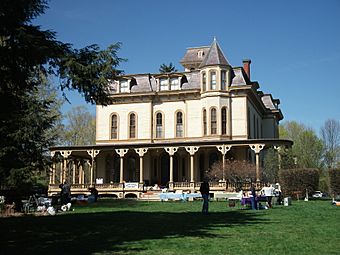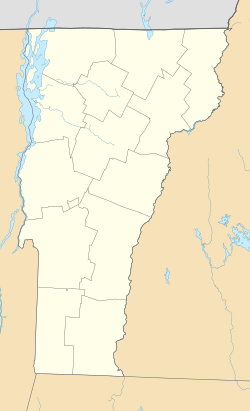Park–McCullough Historic House facts for kids
|
Park–McCullough Historic Governor's Mansion
|
|
|
U.S. Historic district
Contributing property |
|
 |
|
| Location | North Bennington, Vermont |
|---|---|
| Built | 1864 |
| Architect | Diaper & Dudley |
| Architectural style | Late Victorian |
| Part of | North Bennington Historic District (ID80000328) |
| NRHP reference No. | 72000090 |
Quick facts for kids Significant dates |
|
| Added to NRHP | October 26, 1972 |
| Designated CP | August 29, 1980 |
The Park–McCullough Historic Governor's Mansion is one of the most well-preserved Victorian homes in New England. This huge house has thirty-five rooms and sits on 200 acres of land. You can find it near Vermont Route 67A in North Bennington, Vermont.
The mansion was built between 1864 and 1865 by a successful lawyer and businessman named Trenor W. Park (1823–1882). He was born nearby in Woodford, Vermont, but he became very rich by managing mining businesses in California. The famous New York architecture firm Diaper and Dudley designed the house. It cost $75,000 to build, and the Park family moved in on Christmas Day in 1865.
Years later, in 1889–1890, Trenor Park's family made many changes to the house. They wanted to get it ready to host President Benjamin Harrison. He was visiting to celebrate the new Bennington Battle Monument.
The Park–McCullough Historic Governor's Mansion is a great example of an American country house built in the Second Empire style. It also has features from the Romantic Revival style, which was popular at the time. Today, a non-profit group owns the house, and it is open for people to visit.
Contents
The Park Family Story
Trenor William Park's Life
Trenor William Park was born on December 8, 1823, in Woodford, Vermont, near Bennington, Vermont. His family was not rich when he was young. By the time he was 16, Trenor was already studying law. He became a lawyer at age 21.
In 1846, he married Laura V.S. Hall, who was the daughter of Vermont Governor Hiland Hall. They had three children: Eliza “Lizzie” Hall Park (born 1848), Laura “Lila” Hall Park (born 1858), and Trenor “Train” Luther Park (born 1861).
In 1852, Trenor, Laura, and Lizzie moved to San Francisco. Trenor became very successful in California. He managed the Mariposa mines for John C. Fremont. The Park family also made money from other businesses around the world, like banking and railroads. Trenor even became the president of the Panama Canal Railway. He also started the First National Bank in North Bennington, Vermont.
The family returned to North Bennington, Vermont in 1863. Construction on their new home, which they called the “Big House,” began soon after. Trenor William Park even ran for vice-president of the United States in 1864. When he passed away, he left $10,000 to Harvard University.
Trenor Luther Park's Family
Trenor William Park's son, Trenor "Train" Luther Park (1861–1907), married Julia Hunt Catlin. He went to Harvard and imported silks. He was also a leader of the New York Yacht Club and won a sailing trophy. He and Julia sailed across the Atlantic Ocean 75 times! His own large house, called "Hill Crest," was built in New York and is now a country club.
Trenor and Julia had three children. Sadly, Julia died when she was only 3 days old. Elliot Edith died at age 10 after an accident in New York City. Their third child was Frances. Trenor Luther Park died in 1907, just six months after losing his daughter Elliot. After his death, Julia and Frances moved to Paris, France.
During World War I, Julia turned her home in France into a hospital for soldiers. In 1917, she was the first American woman to receive two important awards from France for her help during the war. Julia later married twice more. She passed away in 1947 in Cannes, France.
Eliza Hall Park and the McCulloughs
Trenor William Park's older daughter, Eliza “Lizzie” Hall Park (1848–1938), married John G. McCullough in 1871. John McCullough was born in Delaware in 1835. He was also a lawyer. Lizzie and John had four children: Hall Park McCullough (born 1872), Elizabeth “Bess” McCullough Johnson (born 1873), Ella Sallie Park McCullough (born 1874), and Esther Morgan Park McCullough (born 1888). John G. McCullough was elected governor of Vermont in 1902.
After her mother passed away in 1875, Lizzie became the main person taking care of the house. When her father died in 1882, Lizzie bought the house from her brother and sister. She and her husband became the sole owners. After John passed away in 1915, Lizzie continued to look after the house until she died in 1938.
Even though her son, Hall Park McCullough, inherited the house, her daughter, Elizabeth “Bess” McCullough Johnson, lived there until she passed away in 1965. No other family members lived in the house after Bess died. In 1966, John G. McCullough II (Bess's nephew) inherited the house. In 1968, he offered the property to a new group called the Park–McCullough House Association.
The "Big House" Features
Trenor Park bought the land for the house in North Bennington, Vermont from his father-in-law, Hiland Hall. The “Big House” was built from 1864 to 1865 on almost 200 acres of land. It was designed by the New York architects Diaper and Dudley in the Second Empire style. Over time, the family owned more than 600 acres!
The house was first built as a summer home, a place to escape their New York home. The family usually stayed there from May or June to September or October. Sometimes, they also spent winter holidays at the house. From 1865 to 1965, four generations of the Hall, Park, and McCullough families lived in the “Big House.” The Park family moved in on December 25, 1865. Laura, as the lady of the house, was in charge of buying all the furniture.
The house combines different styles, including Second Empire and Gothic. It was very modern for its time because it had indoor plumbing, hot and cold water, and gas lighting. However, the gas machine was a fire risk, so the Park family's insurance was canceled! Only some of the lights were changed to electricity around 1910. Most rooms had fireplaces for heat. If that wasn't enough, a steam boiler in the basement heated air that rose to the first and second floors.
Diaper and Dudley also designed the Carriage Barn, built between 1865 and 1866. It was later updated to make space for cars, with new floors and walls. The Park family's dog, Abe, had his own dog house near the main entrance. This dog house was later turned into a playhouse for children. It even had a small kitchen with a wood stove and furniture, just like the "Big House."
Around 1889–1890, a sitting room was added above the staircase on the second floor. This was one of many changes made after Lizzie and John took over the house. President Benjamin Harrison (1833–1901) stayed at the house in August 1891. He was there for the celebration of the Bennington Battle Monument. Lizzie and John added the Colonial Revival architecture style to the house in 1889, getting it ready for the President's visit.
The main hall is 75 feet long and has a large fireplace with a cozy bench. The special wooden floor, fireplace, and bench were all put in before the President's visit in 1891. The wallpaper on the walls today is from that same renovation. Even with all the changes over the years, the Park–McCullough house is still one of the best-preserved Victorian mansions in New England. It still looks much like it did originally, and many of the original items used by the family are still there.
When the family first moved in, Lizzie chose a bedroom that remained hers throughout her life in the house. It was next to her parents' master bedroom. When she married John G. McCullough, they continued to live in her childhood room. The “Big House” has 14 chimneys and 35 rooms, including 20 bedrooms! When it was first built, it had 18 fireplaces that burned coal. These fireplaces were made of Italian marble. To keep up with new styles, the fireplaces in the library and main halls were changed to burn wood.
The house has two entrances. One was for guests arriving by carriage (on the South side), and the other was for those who walked (on the East side). When you enter from the South, you see a statue of Hiland Hall above the fireplace. Rooms on the first floor include the Morning Room, Library, Music Room, Dining Room, and Billiard Room. All these rooms connect to the long hallway.
The lady of the house used the Morning Room to meet staff or write letters. The Library was also called the gentlemen's parlor. Trenor Park used it as an office, and so did John G. McCullough when he was Governor. After John passed away, Lizzie changed it into another sitting room. The Music Room was used for short visits from guests, usually lasting only 20 minutes. The dining room table might have been used by the McCulloughs in their New York home. There's also a smaller, round table near the windows for more casual meals.
The billiard room had many fancy and modern things. It had a billiard table that reportedly cost $803 around 1875. In 1930, Lizzie had an elevator installed that went between the first and second floors. Only one bedroom on the second floor didn't have its own bathroom. So, a hole was cut in the wall to add a door and connect it to a bathroom on a lower floor. This bedroom was once used by Esther Morgan Park McCullough, Lizzie's daughter.
Around 1940, part of the west side of the house was removed. This section included the original kitchen and parts of the servants’ living area. Over time, the McCulloughs also changed their gardens. At one point, they even turned them into a tennis court.
The Park–McCullough House Association
The Park–McCullough House Association was created in 1968 after John G. McCullough II offered the house to them. This group is a non-profit organization. It is managed by a Board of Trustees and has both paid staff and volunteers. The Association offers educational programs for both kids and adults. They also give tours of the house and host many special events there. In 1972, the “Big House” was added to the National Register of Historic Sites. The Association officially received ownership of the property in 1975 and 1984.
See also



